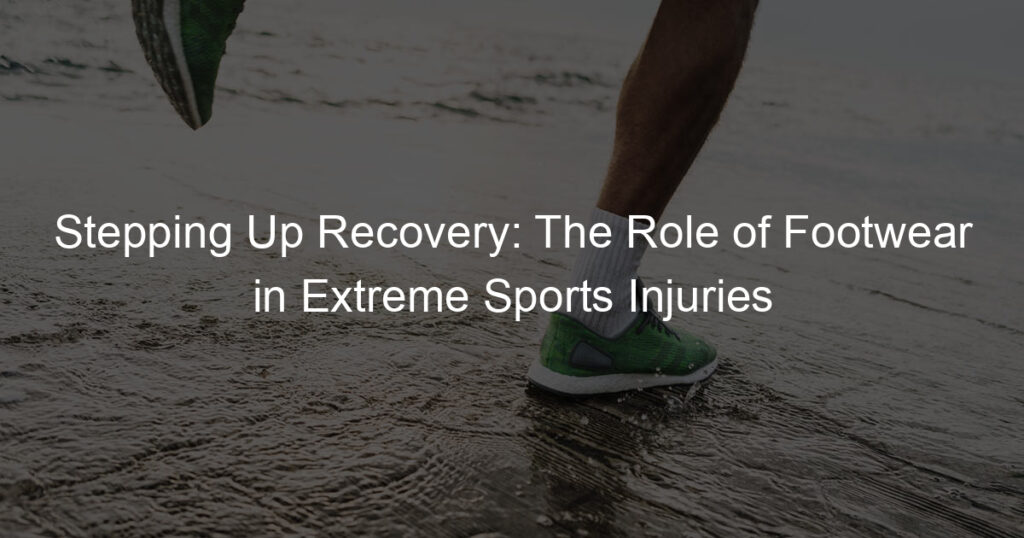
Introduction to Extreme Sports Injury Recovery
Extreme sports, while exhilarating and thrilling, come with their fair share of risks. One of these risks is the potential for injuries. These injuries can range from minor scrapes and bruises to more serious issues like fractures and concussions. In this blog post, we will delve into the nature of extreme sports injuries and the importance of proper recovery.
-
- Understanding the Nature of Extreme Sports Injuries
Extreme sports injuries are often more severe than those experienced in traditional sports. This is due to the high-intensity and high-risk nature of these activities. For instance, a skateboarder might suffer from a sprained ankle, while a rock climber could experience a fall leading to multiple fractures. According to a study, extreme sports athletes are 11 times more likely to suffer a severe injury than participants in regular sports.
-
- The Importance of Proper Recovery
Recovering from an extreme sports injury is not just about healing physically. It’s also about regaining confidence and strength to get back out there. Proper recovery involves rest, physical therapy, and sometimes even surgery. It’s crucial to follow a doctor’s advice and give your body the time it needs to heal. Failing to do so can lead to chronic pain, long-term damage, and a higher risk of re-injury. As the saying goes, “An ounce of prevention is worth a pound of cure.”
In the following sections, we will explore the role of footwear in extreme sports injuries and recovery. We will discuss what to look for in sports injury footwear, how it aids in recovery, and the future of footwear in extreme sports recovery. So, stay tuned!
The Impact of Footwear on Injury in Extreme Sports
Footwear plays a significant role in extreme sports. It can either contribute to or prevent injuries. In this section, we will explore both aspects in detail.
-
- How footwear can contribute to injuries
Footwear that is not designed for the specific demands of an extreme sport can lead to injuries. For instance, shoes that do not provide adequate grip can cause slips and falls. Similarly, footwear that does not offer sufficient support can lead to sprains and strains. Additionally, wearing the wrong size can cause blisters and discomfort, which can distract the athlete and lead to accidents.
-
- The role of footwear in preventing injuries
On the other hand, the right footwear can significantly reduce the risk of injuries. Shoes designed for specific sports provide the necessary support, cushioning, and grip to protect the athlete. For example, rock climbing shoes are designed to provide excellent grip and flexibility, reducing the risk of falls. Similarly, running shoes are designed to absorb shock and support the foot, reducing the risk of injuries like shin splints and stress fractures.
In conclusion, footwear plays a crucial role in extreme sports. Wearing the wrong shoes can increase the risk of injuries, while the right shoes can protect the athlete and enhance performance. Therefore, it is essential for athletes to choose their footwear carefully, considering factors like the demands of the sport, their foot type, and their comfort.
Case Study: Footwear Impact on Injury in Mountain Biking
Mountain biking is an extreme sport that requires not only skill and endurance but also the right gear. Among these, footwear plays a significant role in both performance and safety. In this section, we will delve into a case study that explores the impact of footwear on injury in mountain biking.
-
- Overview of the case study
This case study focused on a group of professional mountain bikers over a period of one year. The aim was to understand the correlation between the type of footwear worn and the incidence and severity of injuries sustained. The study considered factors such as the design, material, fit, and condition of the footwear.
-
- Key findings and takeaways
The study revealed some key insights. Firstly, footwear with a firm grip and ankle support significantly reduced the risk of foot and ankle injuries. Secondly, ill-fitting shoes were a common cause of foot discomfort and blisters, which could lead to more serious injuries. Lastly, the study found that wearing worn-out shoes increased the likelihood of slips and falls.
These findings underscore the importance of choosing the right footwear for mountain biking. It’s not just about comfort and performance, but also about safety and injury prevention. So, whether you’re a professional biker or a weekend enthusiast, remember to give your feet the protection they deserve.
| Key Takeaways |
|---|
| Footwear with a firm grip and ankle support can reduce the risk of foot and ankle injuries. |
| Ill-fitting shoes can cause discomfort and blisters, leading to more serious injuries. |
| Worn-out shoes increase the likelihood of slips and falls. |
Sports Injury Footwear: What to Look For
When it comes to sports injury footwear, there are several key factors to consider. The right shoes can make a significant difference in your comfort and recovery process. Let’s explore what to look for in effective sports injury footwear and how to choose the best pair for your specific sport.
-
- Key features of effective sports injury footwear
Effective sports injury footwear should have the following features:
-
-
- Support: Good sports injury shoes provide excellent arch and ankle support to prevent further injury and aid in recovery.
- Comfort: Comfort is crucial. Look for shoes with cushioning and breathable materials.
- Fit: The shoes should fit well. They should not be too tight or too loose, as this can lead to discomfort or even further injury.
- Durability: Sports injury footwear should be durable and able to withstand the rigors of your recovery process.
- How to choose the right footwear for your sport
-
Choosing the right footwear for your sport is also essential. Here are some tips:
-
- Understand your sport: Different sports require different types of support and cushioning. For example, running shoes need more cushioning in the heel, while basketball shoes require more ankle support.
- Get professionally fitted: It’s worth getting professionally fitted for your sports injury footwear. This ensures that the shoes will provide the right support and fit correctly.
- Consider your injury: The type of injury you have can also influence the kind of shoe you need. For instance, if you have an ankle injury, you might need a shoe with extra ankle support.
Remember, the right sports injury footwear can make a significant difference in your recovery process. So, take your time and choose wisely.
Recovery Footwear: Aiding in Extreme Sports Recovery
When it comes to extreme sports, injuries are often part and parcel of the experience. However, the recovery process doesn’t have to be as extreme. One of the key factors that can aid in a speedy and effective recovery is the right footwear. Let’s delve into the role of recovery footwear and some examples of effective options.
-
- The role of recovery footwear in healing
Recovery footwear plays a crucial role in healing after an extreme sports injury. These specially designed shoes provide the necessary support to the injured foot, reducing strain and promoting healing. They are crafted to ensure comfort while also maintaining the correct foot posture, which is essential for recovery. The cushioning in recovery footwear absorbs shock, reducing the impact on the injured area and allowing the foot to heal faster.
-
- Examples of effective recovery footwear
There are several types of recovery footwear available in the market, each designed to cater to specific needs. Here are a few examples:
-
- Orthopedic Shoes: These are designed with extra depth to accommodate custom orthotic devices. They also have a wider toe box to prevent pressure on the toes.
- Post-Operative Shoes: These are used after foot surgery to protect the foot and provide the necessary support during the healing process.
- Offloading Shoes: These are used to offload pressure from specific areas of the foot. They are often used for diabetic patients but can also aid in sports injury recovery.
Choosing the right recovery footwear can significantly impact the speed and effectiveness of your recovery process. Remember, it’s not just about getting back on your feet; it’s about doing so in a way that ensures your long-term health and mobility.
Case Study: The Impact of Recovery Footwear on a Skateboarding Injury
- Overview of the case studyOur case study focuses on a 15-year-old skateboarder named Jake. Jake was an avid skateboarder, spending hours every day practicing his tricks. Unfortunately, he suffered a severe foot injury while attempting a complex trick. The injury led to a prolonged period of rest and recovery. During this time, Jake started using specially designed recovery footwear. The footwear was recommended by his physiotherapist to aid in his healing process.
- Key findings and takeawaysAfter using the recovery footwear for a few weeks, Jake and his physiotherapist noticed significant improvements in his healing process. The swelling in his foot reduced quicker than expected, and he was able to regain mobility faster. Jake also reported that the footwear was comfortable and helped alleviate the pain.
Before Using Recovery Footwear After Using Recovery Footwear Severe swelling and pain Reduced swelling and pain Limited mobility Improved mobility The case study of Jake’s recovery highlights the potential benefits of using recovery footwear after a sports injury. It suggests that such footwear can play a crucial role in speeding up the recovery process, reducing pain, and improving mobility. However, it’s important to remember that each injury and recovery process is unique. Therefore, it’s always best to consult with a healthcare professional before making any changes to your recovery plan.
The Impact of Footwear on Sports Injury: A Deeper Dive
Footwear plays a crucial role in sports, not only in enhancing performance but also in preventing injuries. Let’s take a deeper dive into the science behind this and understand how the right footwear can make a significant difference.
- Exploring the science behind footwear and injury
Footwear is more than just a fashion statement in sports. It’s a piece of essential equipment that can protect athletes from injuries. The science behind this is quite fascinating.
When we run, jump, or make any athletic move, our feet absorb the impact. This impact can cause stress on our joints and muscles. The right footwear can help distribute this impact evenly, reducing the risk of injury.
For example, running shoes are designed with cushioning to absorb the shock of each step. This reduces the stress on the runner’s knees and ankles, preventing injuries like sprains and strains.
- How footwear can alter athletic performance
Footwear doesn’t just protect athletes from injuries; it can also enhance their performance. Different sports require different types of movements, and the right footwear can support these movements effectively.
For instance, basketball shoes are designed with a high-top to provide ankle support for the frequent jumping and lateral movements in the game. This not only prevents ankle injuries but also allows players to move more swiftly and confidently.
Similarly, soccer cleats have studs on the bottom to provide traction on the grass field. This helps players maintain their balance and speed, enhancing their performance in the game.
In conclusion, the right footwear is a game-changer in sports. It not only reduces the risk of injuries but also boosts athletic performance. So, whether you’re an athlete or a sports enthusiast, make sure to invest in the right footwear for your sport.
| Sport | Footwear Feature | Benefit |
|---|---|---|
| Running | Cushioning | Shock absorption, reducing stress on joints |
| Basketball | High-top | Ankle support for jumping and lateral movements |
| Soccer | Studs | Traction on grass field, maintaining balance and speed |
Sports Injury and Footwear: A Comprehensive Guide
When it comes to sports injuries, many factors can contribute to their occurrence. One often overlooked aspect is the role of footwear. In this guide, we will explore the relationship between sports injuries and footwear, and how the right shoes can be used to prevent injuries and aid in recovery.
- Understanding the relationship between sports injuries and footwear
Footwear plays a crucial role in sports performance and injury prevention. Wearing the wrong type of shoes can lead to discomfort, poor performance, and even injuries. For instance, running shoes are designed to absorb shock and provide support for forward motion, while basketball shoes offer ankle support for the side-to-side movements. Wearing running shoes for a basketball game can increase the risk of ankle sprains.
According to a study by the American Academy of Orthopaedic Surgeons, more than 25% of all injuries are foot and ankle related, and many of these can be attributed to inappropriate footwear. This highlights the importance of wearing the right shoes for the right activity.
- How to use footwear to your advantage in injury prevention and recovery
Choosing the right footwear can significantly reduce the risk of sports injuries. Here are some tips:
- Choose activity-specific shoes: Different sports require different types of support. Always choose shoes designed for the specific activity you’re participating in.
- Proper fit is crucial: Shoes that are too tight can cause blisters and black toenails, while shoes that are too loose can lead to instability and accidents. Your shoes should fit comfortably, with enough room for your toes to move.
- Replace worn-out shoes: Over time, shoes lose their cushioning and support. It’s important to replace them regularly to ensure they provide the necessary protection.
When it comes to recovery, footwear can also play a role. For instance, shoes with good arch support can help alleviate pain from plantar fasciitis, while cushioned shoes can reduce stress on joints for those recovering from knee or hip injuries.
Remember, while footwear is an important factor in sports injury prevention and recovery, it’s just one piece of the puzzle. Always combine it with proper training, warm-ups, cool-downs, and listen to your body’s signals to stay safe and injury-free.
Footwear for Injury Recovery: A Buying Guide
When it comes to recovering from an extreme sports injury, the right footwear can make a world of difference. This guide will help you understand what to look for when buying recovery footwear and introduce you to some of the top recommended brands and models.
- What to Look for When Buying Recovery Footwear
Choosing the right recovery footwear is crucial for a smooth and quick recovery. Here are some key factors to consider:
- Comfort: Your recovery shoes should be comfortable to wear for extended periods. Look for shoes with cushioning and a soft insole.
- Support: Good recovery shoes provide excellent arch and heel support to alleviate pressure on the injured area.
- Fit: The shoes should fit well. They shouldn’t be too tight or too loose, as this can cause further injury.
- Material: Choose shoes made from breathable materials to keep your feet dry and comfortable.
- Top Recommended Brands and Models
There are several brands that are renowned for their recovery footwear. Here are a few top picks:
- New Balance: Known for their supportive and comfortable shoes, New Balance offers a range of models suitable for injury recovery.
- Brooks: Brooks shoes are designed with advanced cushioning technology, making them a great choice for recovery footwear.
- ASICS: ASICS offers a variety of shoes with excellent arch support, ideal for those recovering from foot injuries.
Remember, the best recovery shoe is the one that fits you well and meets your specific recovery needs. Always consult with a healthcare professional before making any changes to your recovery plan.
Extreme Sports Injury and Footwear: The Future
As we look ahead, the future of extreme sports injury and footwear is exciting. With advancements in technology and new trends emerging, the way athletes recover from injuries is changing for the better. Let’s explore what the future holds.
-
- Emerging trends in sports injury footwear
One of the most exciting trends in sports injury footwear is the use of smart technology. Manufacturers are now creating shoes that can monitor an athlete’s movement and provide real-time feedback. This can help prevent injuries and improve performance.
Another trend is the use of lightweight materials. These materials can provide the same level of support as heavier ones, but without the extra weight. This can make a big difference in an athlete’s comfort and mobility.
Finally, there’s a trend towards more personalized footwear. This means shoes that are designed to fit an athlete’s specific foot shape and movement patterns. This can help reduce the risk of injury and improve recovery times.
-
- How technology is changing the game
Technology is playing a big role in the future of sports injury footwear. For example, some companies are using 3D printing to create custom-fit shoes. This can provide a level of comfort and support that’s hard to achieve with traditional manufacturing methods.
Another example is the use of sensors in shoes. These sensors can monitor things like pressure points and stride length. This information can be used to adjust the shoe’s design and provide better support where it’s needed most.
Finally, there’s the use of virtual reality in rehabilitation. Athletes can use VR to simulate their sport and practice their movements in a safe environment. This can help speed up recovery and get them back in the game faster.
In conclusion, the future of extreme sports injury and footwear is bright. With new trends emerging and technology advancing, athletes can look forward to better support, improved comfort, and faster recovery times. It’s an exciting time to be an athlete!
Conclusion: Footwear in Extreme Sports Recovery
As we wrap up our discussion on the role of footwear in extreme sports recovery, let’s take a moment to revisit the key points we’ve covered and share some final thoughts.
-
- Recap of key points
In our journey through this topic, we’ve learned that footwear plays a crucial role in both the prevention and recovery of injuries in extreme sports. We’ve discovered that the right shoes can provide the necessary support and cushioning, reducing the risk of injury. We’ve also explored how specialized recovery footwear can aid in the healing process, providing comfort and promoting better circulation.
-
- Final thoughts on the role of footwear in extreme sports injuries
Footwear, as we’ve seen, is more than just a fashion statement in the world of extreme sports. It’s a tool for protection, a means of prevention, and a vital component in recovery. Investing in the right footwear can make a significant difference in an athlete’s performance and longevity in their chosen sport. As we look to the future, we can expect to see continued advancements in footwear technology, further enhancing its role in injury prevention and recovery.
Remember, the right footwear is just one piece of the puzzle in extreme sports safety. It’s equally important to practice proper technique, maintain physical fitness, and listen to your body’s signals. Stay safe and enjoy the thrill of extreme sports!











